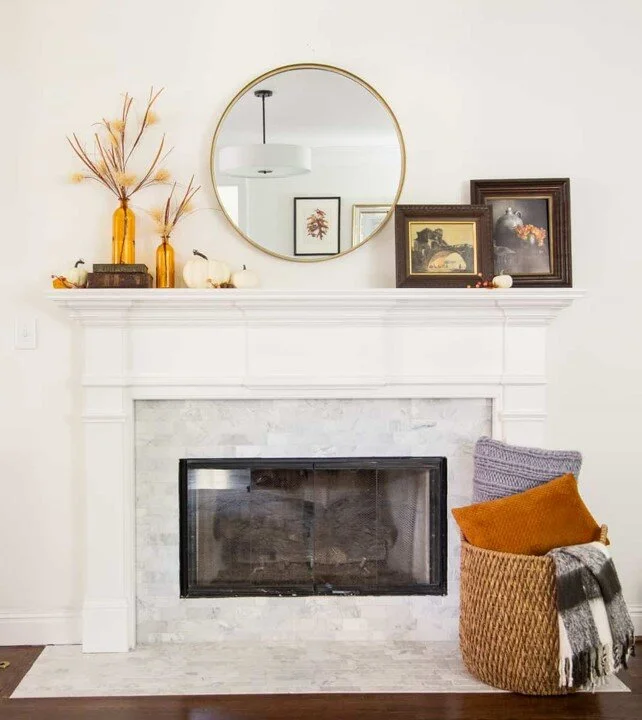I have a lot of opinions.
I guess that comes from being a design pro for as long as I have.
I’ve seen some stuff.
I thought it would be cathartic to explore some of the bad decorating stuff I see online, or in videos or other places on my daily travels.
I mean no harm to anyone, and most of the names and places in this list of peeves have been changed to protect the innocent, expect my mom. Sorry mom…
Anyway, it’s important to consider the placement of furniture and décor in small or awkward rooms because some things that work in bigger spaces will overwhelm a smaller space. Proper planning of furniture size and placement is important for any size room, but it can mean success or failure in a smaller room.
Let’s get into my 11 peeves about decorating small and awkward shaped rooms.
Prefer to watch instead of read? Here’s a video.
11 Giant TVs
I must share my hypersensitive dislike for large televisions in small spaces.
Pexels, Max Vakhtbovych
I’ve written about this many, many times. I’ve had scores of emails from readers admonishing me for my dislike of these big TVs. I’ve even had heated debates with family over this very topic. (I usually loose, which is probably why I carry the torch for faithfully for this one!)
If the people on your TV are the same size or bigger than the people watching the TV, your TV is too big.
If you can feel the breeze from the epic car chase in the James Bond movie, your TV is too big.
If the room tour on House Hunters looks like it’s an extension of your own room – just through that door…, your TV is too big.
There’s a house I pass every morning on my walk. It’s usually still dark out when I’m going by it and I can see the TV on the wall over the fireplace. It’s HUGE.
It’s definitely more than a foot wider on both sides than the fireplace it hangs above. And, the room is as wide as my living room – in fact the house is very comparable to the size of mine, around 800 square feet.
So, this giant TV is hoovering above the significantly smaller fireplace across a 9’ wide room… What? It just looks bad.
I understand that MANY people like big TV’s. But when they practically swallow the room, it’s overkill.
Now one solution for the permanent big TV could be a projector TV system where a screen is lowered, and the broadcast is projected onto the screen. I like them because it’s out of the way and not on display when not being used. Not sponsored btw.
Amazon
I’m also a fan of the Samsung Frame TV’s, also not sponsored. They turn into art when they’re turned off. So awesome… I still wouldn’t want a huge version of it though.
Amazon
Big TVs simply don’t fit in small spaces. In fact, when they’re jammed in odd, shaped rooms or small spaces, they highlight the oddness of these spaces.
In my opinion, get a smaller TV so as not to overpower the room.
Last one, If you get motion sick watching any Marvel movie, your TV is too big!
10 Chair Rails
Let me start this one out by saying, I understand the purpose of chair rails. And, I’m all for the historic preservation of homes with chair rail moldings. They can be quite beautiful.
Sophisticated Chair Rail, HGTV.com
My peeve is squarely with chair rails in rooms that don’t require chair rails. Like why do you want chair rails in the family room? They belong in the dining room, and they are primarily utilitarian, not decorative. They are meant to protect the walls from getting scuffed by the backs of chairs.
THISisCarpentry
They’re anachronistic in any other context.
My peeve goes even deeper when I see chair rails in small rooms, non-food consuming small rooms, that feature a high contrast in color between the sections of wall above and below the chair rail. You know what I’m talking about…
Decorate This
Why is there a burgundy paint job on the bottom and a buttery beige paint job on the top? This makes me so upset! LOL!
The better way to get this kind of look is to install decorative elements like board and batten or panel molding to enhance the space. I will caution you to pump the breaks on overdoing it in small or oddly shaped rooms. Just as with anything else I’ve said here, anything that highlights an architectural feature that you want to diminish will make it stand out more.
Angela Rose Home
Room for Tuesday
So, although I love this panel molding and this tambour coffee table, if it’s a space I want to hide in plain sight, this will surely not work.
Tommy Bahama
So, leave the chair rail in the dining room and keep it classic, which means ixnay on the high contrast aintpay.
9 Accent Walls
Here’s the deal with accent walls, 1997 called and they want them back. Now, before the villagers with the pitch forks and torches come to storm my castle, accent walls are not the same as focal walls.
flickr
Accent walls are just random walls that someone decides to slap red paint on when all the other walls are beige. This wall isn’t anything special- it’s just a wall. And it’s even worse when the wall is small or angled. What’s the point of highlighting an angled wall?
Now, focal walls are focal points. It’s where the attention in the room goes.
It’s the fireplace wall.
It’s the wall behind the bed.
It’s the wall where the action in the room is happening
Max Vakhtbovych
Décor Pad
A contrast in color on this wall is appropriate because you can send a subliminal message – ‘this is where I WANT you to look in this room.’
Personally, I like to use focal walls to enhance a space. I like color, wallpaper, board and batten, tambour, faux paint techniques. I’ve used them all and will continue to – in the appropriate places.
So, accent walls, boo!
Focal walls, yea!
Highlight the walls where you want the attention to go.
8 Busy or High Color Contrast Curtains
This peeve is certainly my own bias, but I feel very strongly about it. (I can feel the fans of boho coming for me already, lol.)
Okay, little rooms can feel tight and one way to make them feel tighter is to hang super busy, patterned or highly color contrasting curtain panels up. What I mean by this is busy curtains that are drastically different than the wall color.
Houzz
I’m way cool with large and bold art. Not so much with the curtains.
In my opinion bold curtains in small rooms create a visual barrier. They enhance the small size of the space and if you have oddly placed windows, it’s like shinning the bat signal on them. It’s a “hey look at my weird window in the corner of the room when there’s no other window near it” type situation.
Houzz
Contrast this with a window treatment that is similar in color to the wall and suddenly that odd window way over there blends in with the rest of the wall and the glare of oddness melts away.
If you love pattern, and want it in your space, then just get a pattern that has the same coloring as the wall. A color matched “busier” pattern can work just as well as matching the treatments to the wall color.
John Kernick
Look at this, the pattern is all the same- wallpaper IS the pattern of the window treatment, or vice versa. The point is this is how you do pattern and color on window treatments in small and awkward shaped rooms. Yum!
F&P Interiors
So, make your wall color match the window treatments. Keep your color contrast to a minimum, and replicate patterns so you can have impact if you want it.
7 No Variation in Texture, Color or Scale in Décor
Have you ever been in someone’s space and noticed that all the décor was lined up and there was no difference? It’s like they grouped everything together that was similar heights or colors or something.
Mantles Direct
It would be like the visual equivalent of a monotone voice. No inflection, just droning on and on…
So, no matter what size or shape room you have, don’t ignore the opportunity to vary the height, scale, color and texture of your décor. Mix it up!
Bed bath & Beyond
In small or tricky spaces, it can be tempting to play safe and keep things small. A lack of variation in your décor will only draw attention to itself because it’s noticeable. It feels off because the inflection of mixed elements is not there. It feels flat and uninspiring.
Maybe you have a small fireplace wall with a decent size mantle, but the placement of the fireplace is odd.
Maybe the room happens to have fairly tall ceilings throughout. If you place long and short décor on the mantle it will highlight how odd and out of place the fireplace looks.
But if you place a tall tree or sculpture or floor lamp next to the fireplace and then you capitalize on the height of the fireplace wall with a tall mirror or art above the mantle, you’ve now shifted the focus from the odd fireplace to the décor that’s impacting the area around the fireplace. Then, you fill in the remaining space on the mantle with décor that brings in additional texture, color, shape and size to round out the design. This will change the entire dynamic of that space from odd to wow. Give it a try!
Deeply Southern Home
To recap, 86 the lined up and dull décor for stuff that’s different sizes, shapes, colors and textures for a more interesting composition.
6 Small Wall Art
I’m especially not fond of little art in small rooms. I feel it gets lost.
A Glass of Bovino
I understand the instinct. Many people feel like a large piece of art will overwhelm a small space. I get that hesitation, but the opposite is actually true.
Large art on smaller walls is visual impact. It becomes intentional and enhanced, rather than something that just fills up a space.
Eloisexxx, Ebay
I like a dramatic, large piece in a small breakfast nook or a striking oversized photo on canvas in a small entry wall or foyer.
JEREMIAH BRENT
Think about the places that need a little umph in your house.
Could you place big art over your bed, or in a powder room?
Is there a small wall right inside your front entry that’s calling out for a dramatic or dynamic first impression? I say go for it!
Architectural Digest
I feel the same way about small art it in awkward or odd shaped rooms too, but for slightly different reasons.
A small piece of art on an odd wall will only draw attention to the odd wall. This is even more true if the piece is hung too high or too low. It just highlights the feeling that something is off.
Home Décor Bliss
A large piece – that is planned out appropriately – will become the focal point of the space.
Now, the odd wall that you want to downplay disappears behind that awesome big art.
So, embrace large art in small spaces for visual impact and use large art as camouflage for odd or awkward walls that you don’t want to highlight.
5 Shoving Furniture Against Walls
I’ve heard this referred to as wallitis.
It’s a totally made-up word, but it’s when all the furniture in your room is pushed up against the wall – like there’s powerful magnets pulling the sofa and chairs in tight!
Porch Daydreamer
Rooms with multiple doorways, architectural obstructions like built-ins or large fireplaces, bay windows, bump outs and ins, already take up wall space So, unless you want to really dial in on the awkwardness, you should consider floating your furniture placement.
Michael Helwig Interiors
Think about it this way, if you’re letting the room’s structure dictate where you place your furniture, you’re limiting the potential for an appropriate and functional layout for your furniture.
Instead of pushing furniture into predesignated spaces that may be tricky to furnish, float the furniture.
You can usually fit bigger pieces- a larger sofa or maybe a sectional positioned in the room that would have never fit up against a wall.
Floating furniture usually creates new pathways through a space, and they could be more efficient to navigate.
Michael Helwig Interiors
A floating configuration also encourages and enhances conversation seating groups too.
Michael Helwig Interiors
A sofa with a perpendicular chair or a pair of chairs flanking a sofa on either side, or a sofa with a perpendicular loveseat with an accent chair opposite. These are all classic configurations that work very well in floating furniture layouts.
Don’t let awkward walls or tricky spaces dictate where your furniture goes.
If your room is wide enough, try a floating configuration. It will open a ton of interesting vantage points for you!
4 Too Much Furniture
The Indian Express
My closest friends and family know my naughty catch phrase for too much furniture in a room. I call it 20 pounds of s#1t in a 5 lb. bag. Crass, for sure. Accurate, you bet!
Here’s one scenario: there’s too many options for sitting:
Say you have a small room and it’s busting at the seams with too many chairs. You have a main seating area and chairs angled in corners, a bench by a doorway, a cocktail ottoman, a chair with an ottoman, a floating ottoman…
Houzz
Okay, I’m making this all up, but my point is, too much furniture is overstimulating and confusing.
I often say, decorate your room for the life you live every day.
If you don’t have 20 people for dinner every night, do you need seating for 20 people? Could you figure out how to accommodate 20 people once or twice a year? I’ll bet you can…
Big and bulky closed cabinets add weight to a room. They take up physical space and visual space. Think about adding in open storage options like an etagere or open shelving.
Wayfair
So, edit the amount of seating and storage in a small or tricky room down to what you actually need based on your everyday life, and edit the rest until your space feels lighter.
Just know that I appreciate a minimalist style myself, but my house is anything but minimal. I’m always swapping things out, moving things around, putting things away and taking things back out all-the-time. I love my stuff, and I want it to enhance my space with it – just not all of it at the same time. Make sense?
Michael Helwig Interiors
3 Small Area Rugs
Small rugs. Now this one is usually on every designer’s list of peeves and for good reason.
A small rug in a large room looks ridiculous, right? It doesn’t make any kind of impact.
Sandra Best Decor
Well, small rugs in small rooms don’t make much sense either.
Rugs define seating areas. I’ve said it a million times on this blog, they anchor the room. Big room, small room, weird room, rugs will define the space, absorb sounds and give you the opportunity to explore and embrace color, texture and pattern – sometimes all at once!
So, why not go big? Get the largest rug the room can handle. You won’t be sorry.
Michael Helwig Interiors
It’s been my experience that small rooms can handle at least an 8’ x 10’ rug. They won’t overpower the room. They won’t cover too much of the new hardwood floors. And they won’t pose a tripping hazard.
What they will do is help you figure out where to place the furniture because they immediately create a parameter when you put them down.
As a rule, the sofa goes on the longest side of the rug, in this case the 10’ side, secondary furniture, chairs, etc. go on the 8’side.
Michael Helwig Interiors
In a bedroom, the 10’ side is placed under a queen bed so that you have rug to step on getting into and out of bed. Night tables, bedside tables are placed off the rug. So essentially the rug is about 3 quarters under the bed. There’s a little bit of rug extending past the foot of the bed and ending just in front to the bedside furniture.
Michael Helwig Interiors
2 Furniture Placed on an Angle
Houzz
This one is all about the main seating: sofas, sectionals. Beds, desks, you get the picture. It’s the main piece that is sat on, in, or at within the room…
Okay, so this is not on everybody’s small space peeves list, but it is on mine. Angled furniture, in small rooms or in tricky spaces always accentuates the challenges of a room.
A large sofa angled in a small room will shrink the usable floor space. Say you have a room with multiple doorways or angled walls or architectural features that cut into the space like a fireplace with a deep hearth; that angled sofa is just another thing limiting the room’s functionality. And, It’s completely unnecessary.
Michael Helwig Interiors
I’m going to throw my mom under the bus. Sorry mom…
She insists on having her bed angled in her small bedroom. To be fair, her bed has been angled in pretty much all the bedrooms she’s lived in since I can remember. It seems to be her first instinct.
Houzz
Now to be doubly fair, in my first apartments after leaving home, I ALWAYS had my sofa and bed angled in the rooms. I know, I’m a total hypocrite! LOL. I didn’t know any better and that’s just what I was taught.
Now, it wasn’t until I started practicing my craft that I realized angled furniture is:
Difficult to clean around. I never seemed to be able to get all the dust bunnies out from the corners of the furniture that were closet to walls.
Angling my furniture limited the access to adjacent furniture. For example, the footboard of my angled bed always interfered with how far I could open the bottom drawers on my dressers… Go figure…
And, angled furniture always bumps the pieces farther into the room. Not a big deal until you realize that all the subsequent furniture like coffee tables, end tables and ottomans also get bumped farther into the room too. That usually affects the pathways through the space. You’ll find yourself navigating weird angles or pioneering new and treacherous ways into the room. It’s the Dick Van Dyke show opener, remember that?
Sitcomsonline.com
To be fair, I don’t have a problem with angled secondary furniture. I’m all for an angled accent chair or recliner. Chairs arranged this way usually add to the symmetry and balance of a space and make it easier for viewing angles and to be part of a conversation style layout.
Michael Helwig Interiors
Just keep the sofa, bed and desks parallel to the walls.
1 Furniture Blocking Doorways
This is by far my top peeve for any size space, but especially small or awkward spaces.
Tricky rooms often have difficult things like angled walls or bump outs and bump ins that make them tough to arrange.
When you add furniture blocking doorways it makes navigating the room so much harder.
Quora
Large cabinets that stick out past a doorway, yes mom I’m talking to you! Love you, but the China cabinet that’s 24” deep cannot fit where the doorway is only 9” from the corner of the wall!
Fiesta Cabinets
The same goes for any furniture- no matter how small…
Say you have a small foot stool that sticks out into the doorway. Yes, it’s small but you have to move it, or scoot around it to navigate through. What a pain, right?
My rule is if you can’t pass by it freely, or it has to be shifted around to get a clear path, it needs to find a different spot to live.
If a piece of furniture is blocking access into the room, remove it or find a different place for it to be.
Houzz
There it is.. 11 of my biggest peeves for small or awkward rooms:
11. Giant TV’s.
10. Chair Rails Outside of the Dining Room.
9. Accent Walls That Are Not Focal Points.
8. Busy or High Color Contrast Curtains.
7. No Variation in Texture, Color, or Scale in Decor.
6. Small Wall Art.
5. Furniture Shoved Up Against the Wall.
4. Too Much Furniture.
3. Small Area Rugs.
2. Furniture Placed on Angles.
1. Furniture Blocking Doorways.
You may agree with some, and you may disagree with others and that’s okay. Either way, these are some of the many things I think about when designing rooms for my clients.
I always say, if I wouldn’t recommend something in my space, I’ll certainly not recommend it for yours!
Do you have any decorating peeves that drive you batty?
Have you ever had a space that was super challenging to decorate or arrange?
Let me know in the comments below. I love to hear about other people’s decorating hot buttons. Chances are I’ll agree with you!
Let’s talk about it.
Join The Fun
If you enjoyed this post and you want to keep seeing my weekly blog, the best way to do that is to subscribe.
You can subscribe by downloading my 11 Secrets Only Designers Know to Make Your Space Rock. If you’re curious about how decorators and designers make a home look magazine ready, you’ll love taking a gander at these 11 secrets. You’ll learn how to style your room from the floor up and it will work for ANY space you have.
I write about small space design and decorating, sustainable furniture options, positive self care and a variety of do-it-yourself home décor.
I’d love to connect with you!
“Michael Helwig was top-notch, very professional and responsive to my needs. He allowed me time to explore ideas and try out a variety of combinations until we found the perfect fit. Michael provided detailed information and offered beautiful ideas to make my dream living room become a reality. The furniture he sourced has totally transformed my living room space. Everyone that has seen my new living room has one word, WOW! A special thank you to Michael for a wonderful experience.”
“Michael was very knowledgeable and guided us, with great patience and good humor, through the process of designing our dining room and helping us find the perfect sleeper sofa. He offered really helpful advice when we asked questions - which was often - but at no time did we ever feel pushed. He helped me when I felt like I couldn’t make one more decision. When my new furniture finally arrived I realized everything down to the pillows was perfect. I couldn’t be happier!”
Michael is Principal designer and blogger at Michael Helwig Interiors in beautiful Buffalo, New York. Since 2011, he’s a space planning expert, offering online interior e-design services for folks living in small homes, or for those with awkward and tricky layouts. He’s a frequent expert contributor to many National media publications and news outlets on topics related to decorating, interior design, diy projects, and more. Michael happily shares his experience to help folks avoid expensive mistakes and decorating disappointments. You can follow him on Pinterest, Instagram and Facebook @interiorsmh.




















































